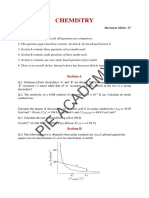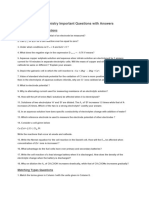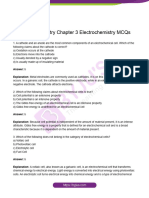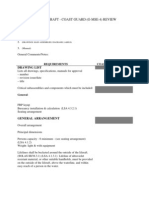0 ratings0% found this document useful (0 votes)
6 viewsElectrochemistry Assignment
Electrochemistry Assignment
Uploaded by
IMMORTAL GAMERCv
Copyright:
© All Rights Reserved
Available Formats
Download as PDF, TXT or read online from Scribd
Electrochemistry Assignment
Electrochemistry Assignment
Uploaded by
IMMORTAL GAMER0 ratings0% found this document useful (0 votes)
6 views4 pagesCv
Copyright
© © All Rights Reserved
Available Formats
PDF, TXT or read online from Scribd
Share this document
Did you find this document useful?
Is this content inappropriate?
Cv
Copyright:
© All Rights Reserved
Available Formats
Download as PDF, TXT or read online from Scribd
Download as pdf or txt
0 ratings0% found this document useful (0 votes)
6 views4 pagesElectrochemistry Assignment
Electrochemistry Assignment
Uploaded by
IMMORTAL GAMERCv
Copyright:
© All Rights Reserved
Available Formats
Download as PDF, TXT or read online from Scribd
Download as pdf or txt
You are on page 1of 4
KENDRIYA VIDYALAYA NDA PUNE-23
CLASS :12 ELECTROCHEMISTRY SUB: Chemistry
1. A cathode and an anode are the most common components of an
electrochemical cell. Which of the following claims about the cathode is
correct?
a) Oxidation occurs at the cathode
b) Electrons move into the cathode
c) Usually denoted by a negative sign
d) Is usually made up of insulating material
2. Which of the following claims about electrochemical cells is true?
a) Cell potential is an extensive property
b) Cell potential is an intensive property
c) The Gibbs free energy of an electrochemical cell is an intensive property
d) Gibbs free energy is undefined for an electrochemical cell
3.Which of the following does not belong in the category of electrochemical
cells?
a) Voltaic cell
b) Photovoltaic cell
c) Electrolytic cell
d) Fuel Cell
4. Which of the following assertions about the main cell is correct?
a) An example of a primary cell is a mercury cell
b) An example of a primary cell is a nickel-cadmium storage cell
c) The electrode reactions can be reversed
d) It can be recharged
5. In a dry cell, which of the following is the electrolyte?
a) Potassium hydroxide
b) Sulphuric acid
c) Ammonium chloride
d) Manganese dioxide
6.Which of the following statements about a lead storage cell (or a lead-acid
battery) is false?
a) It is a primary cell
b) The cathode is made up of lead(IV) oxide
c) The anode is made up of lead
d) The electrolyte used is an aqueous solution of sulphuric acid
7.The conductivity of electrolytic conductors is due to __________
a) Flow of free mobile electrons
b) Movement of ions
c) Either movement of electrons or ions
d) Cannot be said
8.The process of transmitting electric current through an electrolyte’s solution
to decompose it is known as __________
a) Electrolyte
b) Electrode
c) Electrolysis
d) Electrochemical cell
9. In a fuel cell, which of the following can be utilized as a fuel?
a) Nitrogen
b) Argon
c) Hydrogen
d) Helium
10.Which of the following is given to a fuel cell’s cathode?
a) Hydrogen
b) Nitrogen
c) Oxygen
d) Chlorine
11.Standard solution of KNO3 is used to make a salt bridge because
(a) Velocity of K+ is greater than that of NO−3.
(b) Velocity of NO−3 is greater than that of K+.
(c) Velocity of both K+ and NO−3 are nearly same
(d) KNO3 is highly soluble in water.
12.For the electro-chemical cell:
M| M+|| X–| X, E0M+,M = 0.44 V and E0x,x− = 0.33 V
From the data one can deduce that
(a) M+ X → M+ + X– is the spontaneous change
(b) M+ + X– → M + X is the spontaneous reaction
(c) Ecell = 0.77 V
(d) Ecell = -0.77 V
13.Galvanised iron sheets are coated with
(a) Carbon
(b) Copper
(c) Zinc
(d) Nickel
14.Rust is a mixture of
(a) FeO and Fe (OH)3
(b) FeO and Fe (OH)2
(c) Fe2O3 and Fe (OH)3
(d) Fe3O4 and Fe (OH)3
15.The standard reduction potentials of X, Y, Z metals are 0.52, -3.03, -
1.18 respectively. The order of reducing power of the corresponding
metals is:
(a) Y > Z > X
(b) X > Y > Z
(c) Z > Y > X
(d) Z > X > Y
16.Which of the following is not a good conductor?
(a) Cu
(b) NaCl (aq)
(c) NaCl (molten)
(d) NaCl(s)
17.4.5 g of aluminium (at. mass 27 amu) is deposited at cathode from
Al3+ solution by a certain quantity of electric charge. The volume of
hydrogen produced at STP from H+ ions in solution by the same quantity
of electric charge will be:
(a) 44.8 L
(b) 11.2 L
(c) 22.4 L
(d) 5.6 L
18.The amount of electricity required to deposit 1 mol of aluminium from
a solution of AlCl3 will be
(a) 0.33 F
(b) 1 F
(c) 3 F
(d) 1 ampere
19.If Zn2+/Zn electrode is diluted 100 times, then the change in emf is
(a) increase of 59 mV
(b) decrease of 59 mV
(c) increase of 29.5 mV
(d) decrease of 29.5 mV
20.The highest electrical conductivity of the following aqueous solutions
is of?
(a) 0.1 M acetic acid
(b) 0.1 M chloro acetic acid
(c) 0.1 M fluoroacetic acid
(d) 0.1 M difluoro acetic acid
21. The reaction, 3ClO– (aq) → ClO3 (aq) + 2Cl– (aq) is an example of
(a) Oxidation reaction
(b) Reduction reaction
(c) Disproportionation reaction
(d) Decomposition reaction
22.The emf of the cell:
Ni / Ni2+ (1.0 M) // Au3+ (1.0 M) / Au (E° = -0.25 V for Ni2+/Ni; E° = 1.5 V
for Au3+/Au) is
(a) 1.25 V
(b) -1.25 V
(c) 1.75 V
(d) 2.0 V
23.The standard emf of a galvanic cell involving cell reaction with n = 2 is
formed to be 0.295 V at 25° C. The equilibrium constant of the reaction
would be
(a) 1.0 × 1010
(b) 2.0 × 1011
(c) 4.0 × 1012
(d) 1.0 × 102
[Given F = 96500 (mol-1); R = 8.314 JK-1 mol-1]
24.If E°Fe2+/Fe = -0.441 V and E°Fe2+/Fe2+ = 0.771 V, the standard EMF of
the reaction,
Fe + 2Fe3+ → 3Fe2+ will be
(a) 1.212 V
(b) 0.111 V
(C) 0.330 V
(d) 1.653 V
25.A current of 2.0 A passed for 5 hours through a molten metal salt
deposits 22.2 g of metal (at. wt. = 177). The oxidation state of the metal
in the metal salt is
(a) +1
(b) +2
(c) +3
(d) +4
*****
You might also like
- MT 335 3.1 Communition in GeneralDocument6 pagesMT 335 3.1 Communition in GeneralChimwemwe Kaonga100% (1)
- Boiler BasicsDocument55 pagesBoiler BasicsSaravanakumar Alagarsamy100% (10)
- ElectrochemistryDocument10 pagesElectrochemistryakshitha.s1313No ratings yet
- ELECTROCHEMISTRY mcqsDocument5 pagesELECTROCHEMISTRY mcqskartikyadav2655No ratings yet
- ELECTROCHEMISTRYDocument4 pagesELECTROCHEMISTRYSAIRAJ PRABHAKAR PAWARNo ratings yet
- Special Class Electro Chemistry 23Document19 pagesSpecial Class Electro Chemistry 23sheetal10swetaNo ratings yet
- ElectrochemistryDocument2 pagesElectrochemistryKuldeep SharmaNo ratings yet
- Sample Questions - Chapter 15Document6 pagesSample Questions - Chapter 15Rasel IslamNo ratings yet
- MCQinelectrochemistry 64143Document5 pagesMCQinelectrochemistry 64143Echo borgNo ratings yet
- Class 12 Electrochemistry QuestionsDocument4 pagesClass 12 Electrochemistry QuestionsShifaNo ratings yet
- Question Paper ElectrochemistryDocument7 pagesQuestion Paper Electrochemistryvineshuniyal19No ratings yet
- XII Chemistry MCQ Test Series 2 2023 2024 1698760736Document4 pagesXII Chemistry MCQ Test Series 2 2023 2024 1698760736bluewheel28No ratings yet
- Electrochem Question NewDocument9 pagesElectrochem Question NewrjakrithiNo ratings yet
- MCQ On ElectrochemistryDocument8 pagesMCQ On Electrochemistrykashu7183No ratings yet
- 11 - ElectrochemistryDocument6 pages11 - Electrochemistryhumaaot7No ratings yet
- Electrochemistry WorksheetDocument3 pagesElectrochemistry WorksheetEndro Antono0% (1)
- Electrochemistry: E° (Cathode) - E° (Anode) G - nFE F 96,485J/ V X Mols G GDocument15 pagesElectrochemistry: E° (Cathode) - E° (Anode) G - nFE F 96,485J/ V X Mols G GandrewNo ratings yet
- 2 QB Electrochemistry24-25Document6 pages2 QB Electrochemistry24-25mailltempp28No ratings yet
- ElectrochemistryDocument6 pagesElectrochemistrytwinkleparmar0064No ratings yet
- Electrochemistry PreparatoryDocument4 pagesElectrochemistry Preparatorynithinkumarin2006No ratings yet
- 35 ElectrochemistryDocument5 pages35 Electrochemistryasabarish277No ratings yet
- 3.CBQ ElctrochemDocument7 pages3.CBQ Elctrochemincredibleman653No ratings yet
- ElectrochemistryDocument17 pagesElectrochemistryzohaibsalamNo ratings yet
- واجب شامل للمقررDocument30 pagesواجب شامل للمقررOsama AlkinaneNo ratings yet
- Electrochemistry TestDocument3 pagesElectrochemistry TesttusharNo ratings yet
- 6272226-Class 12 - Chemistry - Electrochemistry - WS With Ans. - JeneshaDocument8 pages6272226-Class 12 - Chemistry - Electrochemistry - WS With Ans. - Jeneshahari6127ffNo ratings yet
- Chemistry - SQP - Unit - ElectrochemistryDocument13 pagesChemistry - SQP - Unit - Electrochemistryitsmekarthik16No ratings yet
- 2 QP ElectrochemistryDocument6 pages2 QP ElectrochemistrysachinNo ratings yet
- Electrochemistry FDocument8 pagesElectrochemistry FAshwin Balaji100% (1)
- ch021 Us HistoryDocument27 pagesch021 Us Historyphdf5s2p5gNo ratings yet
- Electro ChemistryDocument7 pagesElectro ChemistryStuti KarnNo ratings yet
- ELECTROCHEMISTRYDocument5 pagesELECTROCHEMISTRYsarahNo ratings yet
- Work Sheet For G10Document2 pagesWork Sheet For G10Firaol GeremuNo ratings yet
- 2 Electrochemistry24 25Document14 pages2 Electrochemistry24 25uak86070No ratings yet
- Tutorial 4 - ElectrochemistryDocument3 pagesTutorial 4 - ElectrochemistryAnis IssabellaNo ratings yet
- ElectrochemistryDocument6 pagesElectrochemistrygangasinghnayal20No ratings yet
- MinrDocument5 pagesMinrrm0518502No ratings yet
- Assignment 1Document2 pagesAssignment 1Oola Simon PeterNo ratings yet
- Electrochemistry - 2 AssignmentsDocument4 pagesElectrochemistry - 2 AssignmentsPritish Dutta100% (1)
- ElectrochemistryDocument4 pagesElectrochemistrylsanthijeyNo ratings yet
- Elec Chem MCQDocument5 pagesElec Chem MCQdwijesh111256No ratings yet
- SUB CHEMISTRY Date27-03-2024Document2 pagesSUB CHEMISTRY Date27-03-2024shankarbannu143No ratings yet
- Eletrochemistry Previous Qns With AnswersDocument8 pagesEletrochemistry Previous Qns With AnswersAkshay SureshNo ratings yet
- CH 17Document15 pagesCH 17sujalgupts526No ratings yet
- Electrochemical CellsDocument5 pagesElectrochemical Cellssanjeevkumarmaner90No ratings yet
- Electro Chemistry: Multiple Choice QuestionsDocument140 pagesElectro Chemistry: Multiple Choice QuestionsjitendratrivediNo ratings yet
- AP Chapter 17 - ElectrochemistryDocument3 pagesAP Chapter 17 - Electrochemistrytcarr1224No ratings yet
- Electrochemistry Question BankDocument11 pagesElectrochemistry Question Bankrranganath305No ratings yet
- Electrochemical Reactions: + Battery - Salt BridgeDocument7 pagesElectrochemical Reactions: + Battery - Salt BridgewscienceNo ratings yet
- Chapter 20 Electrochemistry: General Chemistry, 10e CDN (Petrucci)Document17 pagesChapter 20 Electrochemistry: General Chemistry, 10e CDN (Petrucci)ChemistNo ratings yet
- Chapter 3 ElectrochemistryDocument4 pagesChapter 3 ElectrochemistrykswoqpqqNo ratings yet
- Chemistry 12 Unit Test 1 (2023 24)Document4 pagesChemistry 12 Unit Test 1 (2023 24)itsrayhan.mNo ratings yet
- Electro - Thermo-Chemistry Tutorial SheetDocument3 pagesElectro - Thermo-Chemistry Tutorial SheetluganomwanakulaNo ratings yet
- ElectrochemistryDocument5 pagesElectrochemistryDhanush SNo ratings yet
- 10 FullDocument4 pages10 FullroobanNo ratings yet
- 2.electrochemistry QB (2023-24)Document6 pages2.electrochemistry QB (2023-24)Shana Chandran 18083No ratings yet
- Night Exam CH 4Document10 pagesNight Exam CH 4abdullah011131No ratings yet
- M-CH-2-S-ENGDocument18 pagesM-CH-2-S-ENGrajeevkalota844No ratings yet
- Chapter-Wise Test: Class-XII Chapter-ElectrochemistryDocument2 pagesChapter-Wise Test: Class-XII Chapter-ElectrochemistrySaikat PodderNo ratings yet
- ELECTROCHEMISTRY (QUESTION PAPER).docxDocument5 pagesELECTROCHEMISTRY (QUESTION PAPER).docxirinamahajan123No ratings yet
- Sustainable and Green Electrochemical Science and TechnologyFrom EverandSustainable and Green Electrochemical Science and TechnologyNo ratings yet
- Ebara Quick Discharge ConnectorDocument14 pagesEbara Quick Discharge ConnectorJames Ray MagdadaroNo ratings yet
- Iit MumbaiDocument2 pagesIit Mumbaivijaya025No ratings yet
- IS 516 (Part-2) Sec-1 - 2018Document16 pagesIS 516 (Part-2) Sec-1 - 2018Sai Pavan100% (10)
- Allowed Cheat SheetDocument2 pagesAllowed Cheat SheetNguyễn Tương QuỳnhNo ratings yet
- NIKE Jordan Legacy 312 Low PS CD9055Document94 pagesNIKE Jordan Legacy 312 Low PS CD9055Foo Subb DubbNo ratings yet
- Graft Polymer Polyether Polyols Employing A Silica PDFDocument15 pagesGraft Polymer Polyether Polyols Employing A Silica PDFDenisaMVNo ratings yet
- Casting LectureDocument168 pagesCasting LectureAnonymous rTWwAM0100% (1)
- HW Ch5 (Gases) 2023 2024Document6 pagesHW Ch5 (Gases) 2023 2024hamadaturkman10No ratings yet
- Marley Alutec Price ListDocument92 pagesMarley Alutec Price ListdduffyNo ratings yet
- Determining Remaining Strength of Corroded Pipelines: Houston Section April 10, 2012Document48 pagesDetermining Remaining Strength of Corroded Pipelines: Houston Section April 10, 2012Marco SilvaNo ratings yet
- Material Safety Data Sheet - Atlas CopcoDocument7 pagesMaterial Safety Data Sheet - Atlas CopcoShanmugam ChandranNo ratings yet
- Masil EM 350: Product Type 35% Silicone Emulsion Product DescriptionDocument2 pagesMasil EM 350: Product Type 35% Silicone Emulsion Product DescriptionCARMEN LINARESNo ratings yet
- Topic 9 (Galvanic Cell) - Tutorial - Level 1 AnswerDocument5 pagesTopic 9 (Galvanic Cell) - Tutorial - Level 1 AnswerCheng Xun LeeNo ratings yet
- Possible Uses For Waste Rice Hulls in Building Materials and OtherDocument37 pagesPossible Uses For Waste Rice Hulls in Building Materials and OtherReshan VidurangaNo ratings yet
- Carbide LampDocument6 pagesCarbide LampAdelCNo ratings yet
- Characterization of MaterialsDocument1 pageCharacterization of MaterialsSalem GarrabNo ratings yet
- Mos Pu Foam CompleteDocument4 pagesMos Pu Foam Completeyusnan yazidNo ratings yet
- Nexus 07202015Document2 pagesNexus 07202015acas35No ratings yet
- Briaud J.L. - US DOT Federal Highway Administr. 1992. DMT ManualDocument110 pagesBriaud J.L. - US DOT Federal Highway Administr. 1992. DMT ManualMarcus ViniciusNo ratings yet
- Crack Propagation in Aluminum Sheets PDFDocument248 pagesCrack Propagation in Aluminum Sheets PDFvidal3213No ratings yet
- Chemistry: GCE Ordinary Level (2017) (Syllabus 5073)Document30 pagesChemistry: GCE Ordinary Level (2017) (Syllabus 5073)hadysuciptoNo ratings yet
- Astm C 719-14Document6 pagesAstm C 719-14Валерий ТарасовNo ratings yet
- RoHS Catalogue Letter - Including PhthalatesDocument5 pagesRoHS Catalogue Letter - Including PhthalatesJose RoseNo ratings yet
- Welder Resume ObjectiveDocument7 pagesWelder Resume Objectiveafllxadcf100% (1)
- 1 Enhanced Photocatalytic Activity of TiO2-Zeolite Composite For Abatement of Pollutants (Zeolita Natural)Document8 pages1 Enhanced Photocatalytic Activity of TiO2-Zeolite Composite For Abatement of Pollutants (Zeolita Natural)VANESANo ratings yet
- Rigid Liferaft - Coast Guard (G-Mse-4) Review: Drawing ListDocument12 pagesRigid Liferaft - Coast Guard (G-Mse-4) Review: Drawing ListamitbachchhasNo ratings yet
- Restrepo Rodriguez ACI Journal 110-s56Document18 pagesRestrepo Rodriguez ACI Journal 110-s56CONSTHURAG2012No ratings yet
- Neral Policy - Qualified Welding Procedure Specifications (QWPS) PROCESSPIPING PDFDocument26 pagesNeral Policy - Qualified Welding Procedure Specifications (QWPS) PROCESSPIPING PDFcarlosNo ratings yet

























































































